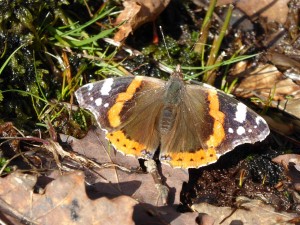
March is the first month that many of us will spot the colourful flutter of butterfly wings heralding that spring has finally sprung. But their reappearance begs the question – where have they been all winter?
Butterflies are insects and unlike mammals and birds need external sources of heat to warm their bodies. This is why butterflies are most active after basking in the sunshine. When their surroundings get really cold butterflies are forced to remain inactive.
So butterflies have a number of strategies to survive the winter cold. Some stay dormant so that they use little energy, overwintering as adult butterflies. Other species lay eggs in late summer or autumn which do not hatch out until the following spring when food is plentiful. Some species survive the winter as caterpillars or a chrysalis hidden within vegetation or sheltered snugly underground.
It’s the overwintered adult butterflies that we see first in the warmth of the spring sunshine, almost magically appearing amongst early spring blooms. The distinctive sulphur-yellow male Brimstone, with its leaf shaped wings, are perfectly camouflaged to hide amongst evergreen ivy during the winter months. Look for it searching for its paler-coloured mate. Peacock, Small Tortoiseshell and Red Admirals are also on the wing. They can hide themselves under shrubs, in ivy or sheds and houses to sleep through the winter.
For many butterfly enthusiasts, the first sighting of the Small White heralds the true start of the butterfly year. This butterfly overwinters as a chrysalis or pupa, emerging only when the weather becomes warm enough for its survival. Orange Tip and Holly Blue also overwinter in the same way.
Caterpillars (larvae) are the most familiar life cycle stage after the winged adults. The Meadow Brown, our commonest and most widespread butterfly, overwinters as a caterpillar. It spends 9-10 months of its life as a caterpillar and 4 months as an adult. The majority of our butterflies overwinter in this stage.
Species which cannot survive our winter, such as the Painted Lady and Clouded Yellow migrate to warmer climates but that is another story….
So keep looking for those fluttering wings as nearly half of our native butterflies (57 species) had emerged by the end of March last year – happy butterfly watching!
Investigations:
Feeding stations: Help newly emerged adult butterflies survive our often unpredictable spring weather by growing early nectar and pollen plants such as cherry, apple, hawthorn, primrose, wallflowers and rosemary .….. which also benefit buzzy bees too.
Plan a butterfly garden: Design and plant a wild flower garden that includes both food-plants for caterpillars and nectar rich flowers. Choose a butterfly species and study its life cycle – which stage does it overwinter in? How can you help it survive the winter, for example – don’t cut back flower borders, grow ivy against fences and walls.
Fluttering butterflies: Cut out a selection of butterfly shapes to colour and study colour and wing patterns. Use field guide books for reference. Butterflies have two pairs of wings – two fore and two hind wings. Wings are covered in scales to give them their colour. When resting their wings fold together – the underside pattern is often camouflaged with a brighter display colour on the upper side. Attach the coloured butterflies onto sticks to have a fluttering adventure around a garden.
Life cycle rely game: Have enough butterfly life cycle sets – egg, larva, pupa and adult – for teams of four children to run and collect a stage. The first team to arrange the sets into the correct order win!
Woolly caterpillar game: Cut different coloured wool into caterpillar sized lengths and hide them amongst flowerbeds, hedgerow, field edge … hide enough for two caterpillars each. The children are sparrows and need to find one caterpillar at a time to feed their hungry chicks. Caterpillars are stuck onto a sticky tongue (strip of double sided tape). Review the coloured caterpillars found and discuss different survival strategies – blending camouflage, warning colours, chemical defence. What sort of caterpillar would they like to be?
Citizen science: Check out The Woodlands Trusts – Nature Calendar survey to record and view seasonal events that show the impact of climate change on our wildlife. Help record the first appearance of butterflies and other insects. www.naturescalendar.org.uk
